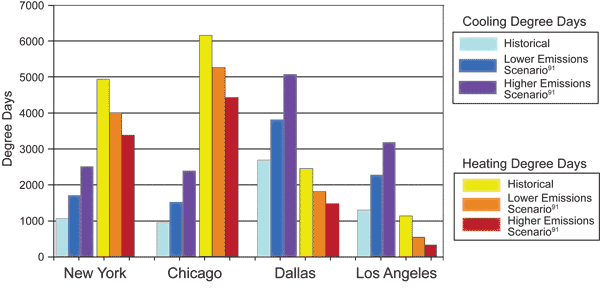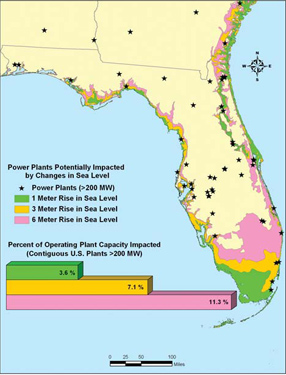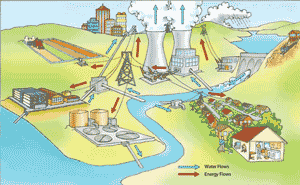Climate Change
Energy Impacts & Adaptation
Energy Impacts & Adaptation

Climate Impacts on Energy
On This Page
Key Points
- Climate change is likely to both increase electricity demand for cooling in the summer and decrease electricity, natural gas, heating oil, and wood demand for heating in the winter. New infrastructure investments may be necessary to meet increased energy demand, especially peak demand during heat waves.
- Climate change could affect the amount of water available to produce electricity or extract fuel. In areas where water is already scarce, competition for water between energy production and other uses could increase.
- Sea level rise and more frequent intense storms could disrupt energy production and delivery by damaging electricity infrastructure, fuel delivery infrastructure and equipment, power plants, or storage facilities.
Related Links
EPA:
Other:
- USGCRP Synthesis Assessment Product 4.5: Effects of Climate Change on Energy Production in the United States
- USGCRP Global Climate Change Impacts in the United States
-
IPCC Fourth Assessment Report, Working Group II

-
NRC America's Climate Choices: Adapting to the Impacts of Climate Change

-
America's Energy Future

Changes in temperature, precipitation, sea level, and the frequency and severity of extreme events will likely affect how much energy is produced, delivered, and consumed in the United States.
Energy plays an important role in many aspects of our lives. For example, we use electricity for lighting and cooling. We use fuel for transportation, heating, and cooking. Our energy production and use is interconnected with many other aspects of modern life, such as water consumption, use of goods and services, transportation, economic growth, land use, and population growth. Our production and use of energy (most of which comes from fossil fuels) also contributes to climate change, accounting for more than 80% of U.S. greenhouse gas emissions. [1]
Temperature, Energy Demand, and Energy Supply
Increases in temperature will likely change how much energy we consume, as well as our ability to produce electricity and deliver it reliably.
- In a warmer climate, Americans would use more electricity for air conditioning and less natural gas, oil, and wood for heating. If the nation's climate warms by 1.8°F, the demand for energy used for cooling would increase by about 5-20%, while the demand for energy used for heating would decrease by about 3-15%. [2] Heating demand would decrease the most in the northern United States, and cooling demand would increase the most in the southern United States. It is unclear how these changes would affect consumer utility bills averaged over the year, especially because significant changes in demand could require infrastructure investments or lead to reliability problems. [3] Changes in energy demand will likely affect greenhouse gas emissions, but the net effect depends on which energy sources are used for electricity and heating.
- Warming is likely to increase summer peak electricity demand in most regions of the United States. [2] Meeting increases in this peak demand could require investments in new energy infrastructure. [2] For example, based on a 6.3 to 9°F temperature increase, climate change could increase the need for additional electric generating capacity by roughly 10-20% by 2050. This would require hundreds of billions of dollars in additional investment. [3]
- A warmer climate may reduce the efficiency of power production for many existing fossil fuel and nuclear power plants because these plants use water for cooling. The colder the water, the more efficient the generator. Thus, higher air and water temperatures could reduce the efficiency with which these plants convert fuel into electricity. [2]

Energy demand is expected to shift by the end of the century. The number of "degree days" refers to the sum of the number of degrees that the day's average temperature is hotter or colder than 65°F over the course of a year. The number of heating degree days is expected to decrease while the number of cooling degree days is projected to increase by 2080-2099. Source: USGCRP (2009)
Energy Use, Energy Production, and Climate Change
The U.S. Department of Energy led the development of a report published by the U.S. Global Change Research Program that investigates the impact of climate change on energy production and use in the United States.
The report summarizes the ways climate change will affect how Americans produce and use energy. It highlights the importance of adapting our energy systems to the projected impacts of climate change, but emphasizes that more research is needed to inform these adaptation decisions.
For more information on options for adapting the energy sector to climate change, see the Energy Impacts & Adaptation page.
Water Availability and Energy
Energy and water systems are connected. Energy is needed to pump, transport, and treat drinking water and wastewater. Cooling water is needed to run many of today's power plants. Hydroelectricity (electricity produced by running water) is itself an important source of power in some parts of the United States.
Changes in precipitation, increased risk of drought, reduced snowpack, and changes in the timing of snowmelt in spring will likely influence our patterns of energy and water use. For example:
- Power plants can require large amounts of water for cooling. On average, a kilowatt-hour of electricity (enough power to run 400 typical compact-fluorescent light bulbs for an hour) requires 25 gallons of water to be withdrawn from rivers or lakes. [3] Parts of the Southeast and Southwest face increased competition for water to meet the demands of population and economic growth while also protecting natural ecosystems. Consequently, these regions are already slowing or stopping plans for new power plants that require large withdrawals of water due to concerns about adequate availability of cooling water. [2] A few power plants rely mainly on air for cooling, but that technology is often more expensive and uses more energy than water-cooled plants.
- More frequent and severe heat waves will likely increase the demand for electricity in the Southeast and Southwest. At the same time, these areas are likely to experience reduced water supplies due to decreased rain and/or increased temperature and evaporation. Since water is necessary for electricity production, these combined effects could stress water resources. For more information about climate change impacts in the Southeast and Southwest, please visit the Southeast Impacts & Adaptation and Southwest Impacts & Adaptation pages.
- Hydroelectric power plants are sensitive to the volume and timing of stream flows. Along the Colorado River, a 1% reduction in stream flow can reduce electricity output by roughly 3%, since water flows through multiple power plants in the river basin. [3] In some regions, especially during times of increased rainfall, dams may have to modify their operations to prevent downstream flooding. [3] Maintaining stream flow for hydroelectric dams could present conflicts with other activities, such as salmon habitat restoration in the Pacific Northwest. [4]
- Growing crops for biomass and biofuel energy could stress water resources in certain regions, depending on the type of crop, where it is grown, agricultural production in the region, and current water and nutrient management practices. [5] Given the many factors involved, more research is needed to understand how climate change may affect these resources. [2]
- Rising temperatures, increased evaporation, and drought may increase the need for energy-intensive methods of providing drinking and irrigation water. For example, desalinization plants can convert salt water into freshwater, but consume a lot of energy. Climate change may also require irrigation water to be pumped over longer distances, particularly in dry regions across the western United States. [3]
For more information about the impacts of climate change on water resources, please visit the Water Impacts & Adaptation page.
Sea Level Rise, Storm Surge, and Extreme Events

Before and after photographs of the "Mars" offshore drilling and production platform, damaged by Hurricane Katrina in the Gulf of Mexico. Source: CCSP (2008) (PDF)
 View enlarged image
View enlarged image
Power plants susceptible to sea level rise in Florida. The bar graph shows the percent of operating plant capacity potentially impacted by several sea level rise scenarios. Source: CCSP (2008) (PDF)
A large portion of U.S. energy infrastructure is located in coastal areas and therefore sensitive to sea level rise and storm surge. For example, fuel ports and the generation and transmission lines that bring electricity to major urban coastal centers are at risk. Changes in the frequency and severity of storms and other extreme events may also damage energy infrastructure.
Disruptions to energy supply due to compromised infrastructure can affect many activities, depending on the destination and final use of the fuel. Coal is used primarily to generate electricity, so disruptions in coal supplies could affect the supply of electricity. Disruptions in the supply of oil would affect the production of transportation fuels. Disruptions in natural gas supply could affect electricity generation, residential and commercial heating, and industrial processes. There are many examples of at-risk energy infrastructure in the United States.
- Several coastal power plants in the United States are less than three feet above sea level. One third of U.S. refining and gas processing capacity lies on the coastal plains next to the Gulf of Mexico. Facilities that import or export coal, gas, and oil are located in coastal regions. [2] Sea level rise and more intense storms and hurricanes in coastal areas could increase the risk of energy supply disruptions.
- Several thousand oil drilling platforms offshore of the Gulf Coast are vulnerable to extreme weather events. For example, Hurricane Ivan in 2004 damaged 24 platforms and Hurricanes Katrina and Rita damaged more than 100 in 2005. [2]
- Flooding and intense storms can damage power lines and electricity distribution equipment. These events may also delay repair and maintenance work. Electricity outages can have serious impacts on other energy systems as well. For example, oil and gas pipeline disruptions following extreme weather events are often caused by power outages rather than physical damage to the infrastructure. [3]
- Railways and marine transportation that move large amounts of oil and coal in the United States are also vulnerable to climate change. More intense rainfall and storms can threaten railways by washing out railway beds. Changes in precipitation could affect marine transportation by reducing the navigability of rivers.
For more information about the impacts of climate change on coastal areas, please visit the Coastal Impacts & Adaptation page.
Wind Speed, Cloud Cover, and Renewable Energy
Climate change could impact wind and solar power, but there is little research in this area. Impacts will depend on how wind and cloud cover patterns change, which are very difficult to project using current climate models.
Renewable Biofuels
- The Energy Policy Act of 2005 established the first Renewable Fuel Standard (RFS), mandating that biofuels be integrated into transportation fuel to reduce greenhouse gas emissions.
- The Energy Independence Security Act (EISA) of 2007 increased the required amount of renewable fuel to 36 billion gallons per year by 2022.
- Annually, the EPA sets volume requirements for each category of renewable fuel. The volumes are determined by technology and the availability of each type of renewable fuel.
- Every three years, the EPA is required to send a report to Congress that evaluates the environmental and resource conservation impacts of increased biofuel production and use.
For more information about the RFS, visit EPA's RFS page. For specific information about the environmental assessment, read the First Triennial Report to Congress.
To learn more about how we can adapt our energy production and use to climate change, please see the Energy Adaptation section.
References
1. EPA (2010). Inventory of U.S. Greenhouse Gas Emissions and Sinks: 1990-2008 (PDF). U.S. Environmental Protection Agency (EPA).
2. USGCRP (2009). Global Climate Change Impacts in the United States . Karl, T.R., J.M. Melillo, and T.C. Peterson (eds.). United States Global Change Research Program. Cambridge University Press, New York, NY, USA.
3. CCSP (2007). Effects of Climate Change on Energy Production and Use in the United States . A Report by the U.S. Climate Change Science Program and the subcommittee on Global change Research. Wilbanks, T.J., V. Bhatt, D.E. Bilello, S.R. Bull, J.Ekmann, W.C. Horak, Y.J. Huang, M.D. Levine, M.J. Sale, D.K. Schmalzer, and M.J. Scott. Department of Energy, Office of Biological & Environmental Research, Washington, DC, USA.
4. IPCC (2007). Climate Change 2007: Impacts, Adaptation, and Vulnerability . Contribution of Working Group II to the Fourth Assessment Report of the Intergovernmental Panel. Parry, M.L., O.F. Canziani, J.P. Palutikof, P.J. van der Linden, and C.E. Hanson (eds.). Cambridge University Press, Cambridge, United Kingdom.
5.NRC (2008). Water Implications of Biofuels Production in the United States . Committee on Water Implications of Biofuels Production in the United States, National Research Council. The National Academies Press, Washington, D.C.


